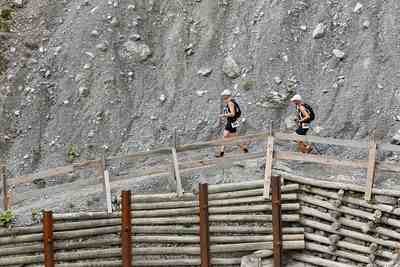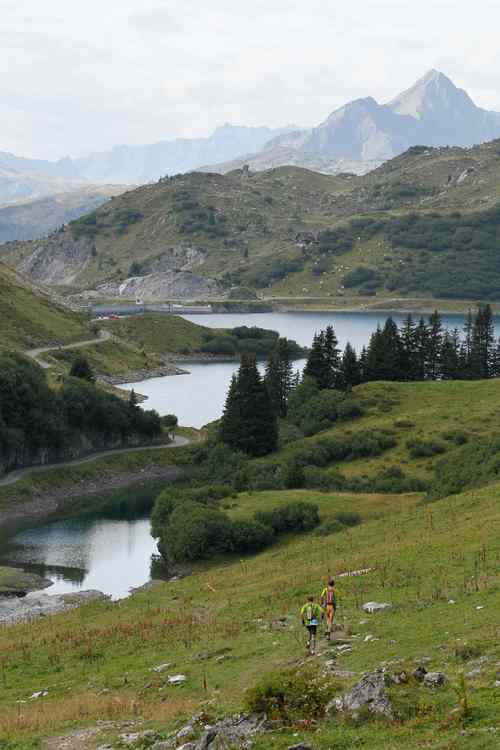Last year, my fiance and I tackled the Gore-Tex TransRockies Run in Colorado as a co-ed team. The trail running stage race covers 115 miles over six days in the Rocky Mountains. I attended the race as a journalist, wrote about the event and figured it might be one of the toughest athletic events Charlie and I would take on together.
That's until I heard of the TransAlpine Run. By virtue of my experience covering TransRockies as a member of the media for the past two years, I've been on the PR mailing list for a stage race in Europe. Also sponsored by Gore, the trek through the Alps travels a daunting 320 kilometers (or 199 miles) over eight days. On average, each of the eight days covers 40 kilometers (or roughly 25 miles) of steep, mountainous terrain. Charlie and I have both completed marathons and 50Ks, but we typically do a race and then chill out for days or weeks. Running that kind of distance back to back eight times over is not something we've ever attempted.
Even though the course sounds a bit over our current ability level, I couldn't help but feel intrigued when I received an email from the Gore-Tex TransAlpine Run PR team saying that the 2012 race had sold out. The event has already drawn 250 teams from all over the world, representing 32 different countries. Despite the difficulty level, a good number of characteristics of the TransAlpine Run intrigued me.
For one, the run goes through Germany, Austria and Italy, enabling runners to explore a part of the world that I've never been to. Photographs and videos of the Alps route are absolutely spectacular, showcasing meadows, mountain peaks and craggy, rugged rock formations. In between running, participants get the chance to recuperate in quaint European towns. It was easy to envision sipping Italian espresso in the morning, taking in stunning vistas during the day and relaxing with a glass of wine at an outdoor café in the afternoon. (Whether this represents the reality of the TransAlpine Run or my own romanticized version is yet to be determined. It's likely a bit more painful than the above description.) This trailer of Heaven and Hell, a documentary film made from last year's TransAlpine Run, gives a glimpse of the breathtaking scenery.
I also felt drawn to the international aspect of the race. Whereas the TransRockies Run in Colorado draws a majority American crowd, with some foreigners, the TransAlpine runners really come from all over the world. When I looked at the registered participants for this year's run, I saw the most came from Germany, with other teams from Italy, Austria, Spain, Switzerland, Japan, Russia, England, Australia, France and other countries. Only a handful of Americans are signed up, which would make us a definite minority. I love the idea of getting to run alongside and socialize with people from across the world. Perhaps I'd even learn a little German to complement my very German name! (Hablo Español... German, not so much!)

But despite the many enticements that the TransAlpine Run provides, it will have to remain on my bucket list of races to do some day. Charlie and I are in the midst of planning a wedding and honeymoon for this July, and neither are cheap endeavors. Alas, TransRockies is equally costly. Aside from the 1,390 Euro per team entry cost of the TransAlpine Run (about $1,800), participants must pay for airfare to and from Europe. Unless you want to sleep on cots in gymnasiums in the host communities, you also pay for hotels each night in the towns the race stops in. Factoring in meals out and transport from the start and finish of the race to airports, it wouldn't be a cheap vacation.
In addition, if we decided to tackle the TransAlpine Run, we'd have to seriously step up our running. Since doing the North Face 50K in early December (the weekend we became engaged), we've adopted a low-key attitude toward getting the miles in. I've been loving the break from long-distance running, and a TransAlpine entry would definitely change that path.
The practical side of me won out this time around, so I won't be traveling to the TransAlpine Run this September to write about the race. This year, the focus remains on getting married and other new life endeavors. I'm not hanging up the hat for good on stage racing, however. Hopefully, I'll take on the Alps one autumn, either while I'm still young or a decade or two down the road.
For more by Heidi Dietrich, click here.
For more on fitness and exercise, click here.
